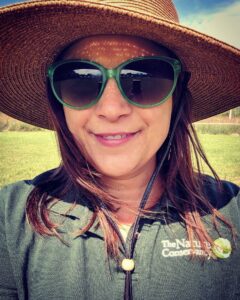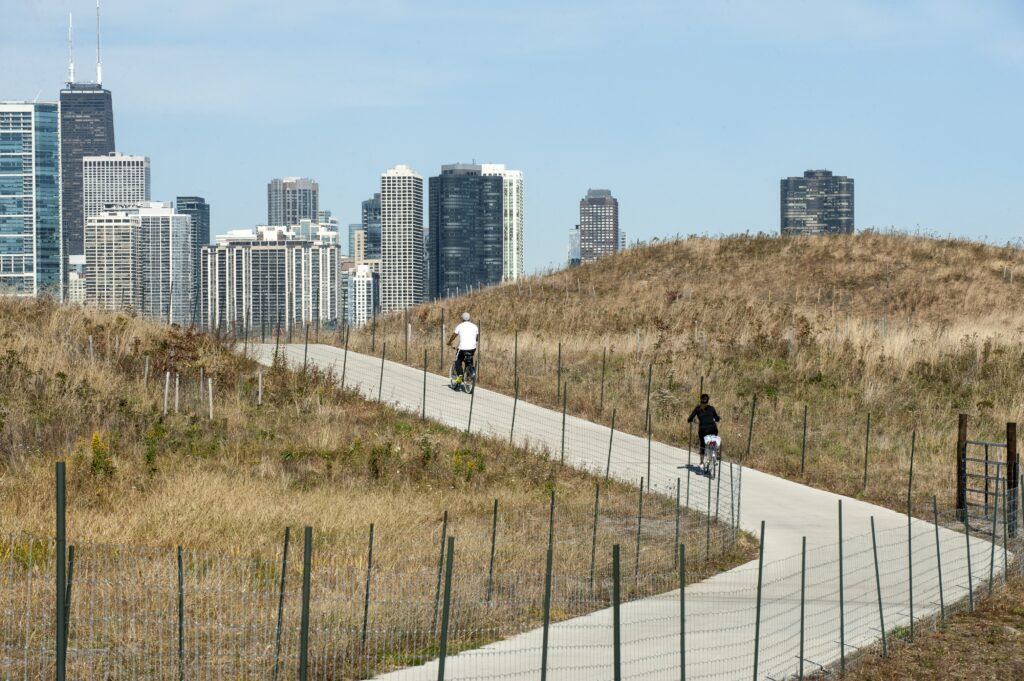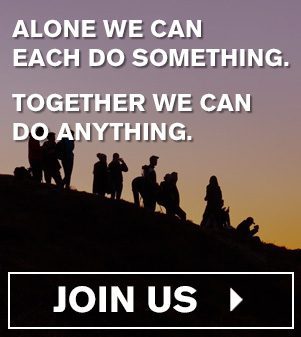Q&A with Brooke Thurau, Conservation Partnership and Network Specialist for The Nature Conservancy in Chicago
By Kassondra Kloos
The Outdoor Foundation Thrive Outside Initiative is a national network of partners working to create a more inclusive and accessible outdoor experience for all. In this Impact Stories series, we talk to local Thrive Outside leaders to learn more about their community and their vision for the future.
Chicago has a wealth of outdoor opportunities within—theoretically—easy reach of its urban center. But lack of transportation, a history of discrimination, and manufacturing industries make it hard for many families to get there. The Nature Conservancy, the backbone organization of Thrive Outside Chicago, is working to connect, galvanize, and fund grassroots organizations throughout the city to meet people where they are.
We asked Brooke Thurau, who runs the organization’s Volunteer Stewardship Network, what to expect from the city’s Thrive Outside Initiative.
What are the barriers to outdoor access in the Chicago area?
Chicago has a history of redlining. Black and brown communities, particularly on the south and west sides, have historically been excluded from outdoor programming. They’ve also taken the brunt of environmental injustices. Industry in these communities has caused serious health problems for children, including asthma. There’s also a lack of accessible green space, and transportation in general is an issue. A lot of people want to visit the forest preserves and parks, but they can’t because they don’t have cars. Additionally, many people don’t feel safe in these spaces.
How do you get people more comfortable with the outdoors if they don’t feel safe playing outside, in nature?
It takes time. And a lot of trust-building. One of our key partners in the Chicago Thrive Network helps support and manage the natural areas on the south side. To try to encourage people from the community to participate in restoration workdays, a staff member hung flyers in local businesses. People weren’t showing up, so she started going to community-based health and wellness organizations and meetings. She went to teachers and had a lot of conversations about what the barriers were, then found different ways to engage people and help them be comfortable in the outdoors. So a lot of times, she brought nature to them. The Volunteer Stewardship Network provided funding and she held an outdoor festival at one of the natural areas with games for kids and engagement opportunities for adults in the parking lot area, so it wasn’t inside the natural area. There were groups there that brought rehabilitated animals they could introduce to the kids and their parents. They took a first step, not expecting folks to go into the forest and hike, but starting slowly with small introductions to the forest.
What goals are you working toward through the Thrive Outside Initiative?
Our goal is not to build a new network, because the work is already being done. Our goal is to provide capacity to what are often volunteer-run organizations. I’m excited to really be able to provide the support these organizations need, to help them strengthen the work they’re already doing, and to provide much-needed funding. A lot of these organizations aren’t 501(c)(3) organizations, so they can’t be recipients of funding because they don’t have that status. So they rely on community donations and volunteer time. We’re really excited to be able to provide small grants, and maybe even some larger capacity-building grants, tools and supplies, and outdoor gear—the things these organizations lack because they’re so community- and grassroots-based.
Some organizations don’t feel comfortable writing the grants or are really intimidated by the process, so we have offered to do oral applications. An organization can jump on a Zoom call and answer the questions verbally, and then I’ll type them out and have someone else review those applications so that it’s equitable. This has taught us that we need to make grant applications more accessible. We want people to feel comfortable and to be able to enjoy the outdoors, but there are also barriers in the process. We want to consider why some groups wouldn’t apply, and ensure we’re sharing the information widely so that people aren’t being left out.
How have you seen the collective impact model benefit the goals you’re working toward?
We’re working to build capacity and bring organizations together. The Nature Conservancy’s Urban Conservation Program has been working with a lot of grassroots organizations for years, which includes places of worship, community gardens, environmental justice organizations, and more. There’s a huge environmental justice movement in Chicago given the damage to communities from industry. There are stewardship and affinity groups like Out in Nature, which is a group of LGBTQIA+ members getting outdoors together. Some of these groups need, say, binoculars, or birding guides. Through Thrive Outside, we’ll be able to provide these groups with the things they need to enjoy the outdoors.
We’ve also been able to connect people with varying levels of knowledge. So, a brand-new community garden whose leaders have never done this work before but saw the need in the community can connect with other community gardens that have been around for a long time so they don’t have to start from scratch.
Can you share an example of another organization that’s working to bring down these barriers?
There’s an organization that’s part of the Volunteer Stewardship Network, which we’re hoping to engage through the Thrive Outside network. It’s a family-run organization called All Things Through Christ Outreach Ministries. They’re in West Englewood, on the west side of Chicago, and they’re in a food desert. At the time this outreach ministry started, there were no green spaces in the area, and with public transportation being the primary mode of transportation, people were unable to get to and from the nearest grocery store. People resorted to gas stations and liquor stores for snacks, so All Things Through Christ started distributing one bag of essential food and personal hygiene items once a month out of the lower level of their church.
This monthly distribution has expanded into a full-service community outreach organization, offering residents access to a full-service weekly client choice food pantry and a youth job skills development and mentorship program. The family and its partners realized the health disparities plaguing this community and the lack of access to healthcare and fresh fruits and vegetables, and they began to steward land contiguous to the building site of their future community outreach center. They’ve been growing food and flowers and educating the community about healthy eating and the environment. They also run programs for youth and adults to engage people in growing flowers and vegetables in raised garden beds, so kids get to dig their hands into the dirt and plant seeds and harvest plants that become meals. Over the summer, the kids get to watch things grow slowly. A lot of these children and adults live in rental spaces, such as highrises, that don’t have yards or landscaping, and they don’t really even have grass in their communities, so this is life-changing and brings hope to the community.
How do you collaborate with other groups and uplift other organizations’ work?
I like the word “uplift.” I’ve been in the conservation field for 15 years. My graduate research was based on equity in conservation and I did a lot of work in Central America, in Panama. I saw the same thing over and over where large conservation organizations, with good intentions, would go into a community where there’s a valuable resource and kind of go about it all the wrong way. Like, “We’re here, this is what we’re gonna do, and you can partner with us, but this is our plan.” Now, our approach through the Nature Conservancy, especially in our city’s work, is to meet organizations where they are.
What does that look like?
We don’t want to reinvent the wheel, and we don’t have a desire to tell these groups what to do, like what the conservation field has done in the past.
It’s important to go to places of worship, attend environmental justice meetings or events, go to fairs or events in the communities where there are needs and organizations already working, and really just listen. I think that is one of the most important things, just to go into communities and listen and get to know one another and find out what’s really going on. There are a lot of similarities among these communities in Chicago, but there are a lot of differences, too. They’re very unique, with a unique set of barriers and a unique set of solutions. I think the goal is to really learn the needs of each one and build trust.






